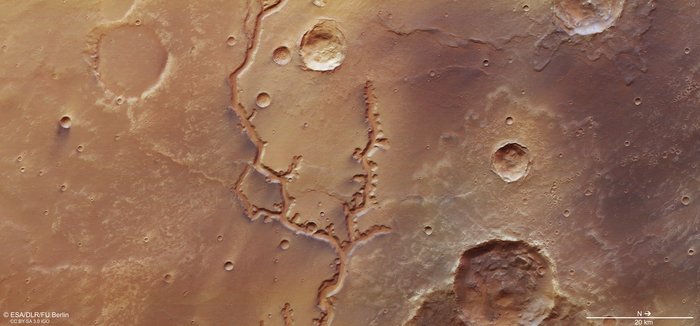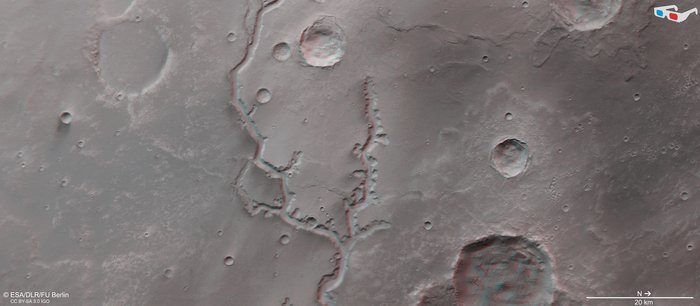

Topographic view of Nirgal Vallis. November 16, 2018. Image via ESA/DLR/FU Berlin.
These new images from ESA’s Mars Express spacecraft, released October 10, 2019, show an ancient, dried-up river system that stretches out for nearly 435 miles (700 km) across the surface of Mars, making it one of the longest valley networks on the planet. This ancient valley system, named Nirgal Vallis, was once filled with running water that spread across Mars. The area lies just south of the planet’s equator, and scientists think it was been shaped by a mix of flowing water and impacts from rocks from space smashing into the Martian surface.
You can see evidence of both of these mechanisms in these images. For example, in the image below, see the impact craters, some large and some small, can be seen speckled across the ochre, caramel-hued surface, and a tree-like, forked channel cuts prominently through the center of the frame.
EarthSky 2020 lunar calendars are available! They make great gifts. Order now. Going fast!

The dried-up river valley on Mars named Nirgal Vallis. November 16, 2018. Image via ESA/DLR/FU Berlin.

Nirgal Vallis in context. The area outlined by the bold white box indicates the area imaged by the Mars Express High Resolution Stereo Camera on November 16, 2018. Image via NASA MGS MOLA Science Team.
According to a statement from ESA:
Nirgal Vallis is a typical example of a feature known as an amphitheater-headed valley. As the name suggests, rather than ending bluntly or sharply, the ends of these tributaries have the characteristic semi-circular, rounded shape of an Ancient Greek amphitheater. Such valleys also typically have steep walls, smooth floors, and, if sliced through at a cross-section, adopt a ‘U’ shape. The valleys pictured here are about 200 meters (656 feet) deep and 2 kilometers (1.2 miles) wide, and their floors are covered in sandy dunes; the appearance of these dunes indicates that martian winds tend to blow roughly parallel to the valley walls.
We see valleys like this often on Earth, including valleys found in the Chilean Atacama Desert, the Colorado Plateau, and on the islands of Hawaii. Mars also hosts a few of them, with Nanedi Valles and Echus Chasma joining Nirgal Vallis as clear examples of this intriguing feature. Both of these features also resemble terrestrial drainage systems, where meandering, steep-sided valleys – thought to have been formed by free-flowing water – have carved their way through hundreds of kilometres of martian rock, forging through old volcanic plains, lava flows, and material deposited by strong martian winds over time.

Perspective view of Nirgal Vallis. Image via ESA/DLR/FU Berlin.
Scientists say that valleys such as Nirgal Vallis, which are ubiquitous in the low-latitude regions surrounding the martian equator, indicate that these areas once experienced a far milder, wetter and more Earth-like climate.

If you’ve got 3D glasses, check out this image, which shows Nirgal Vallis, a dried-up river valley on Mars, in 3D. Image via ESA/DLR/FU Berlin.
Bottom line: Images from the ESA Mars Express show traces of an ancient river valley on Mars.
from EarthSky https://ift.tt/2psFAq0


Topographic view of Nirgal Vallis. November 16, 2018. Image via ESA/DLR/FU Berlin.
These new images from ESA’s Mars Express spacecraft, released October 10, 2019, show an ancient, dried-up river system that stretches out for nearly 435 miles (700 km) across the surface of Mars, making it one of the longest valley networks on the planet. This ancient valley system, named Nirgal Vallis, was once filled with running water that spread across Mars. The area lies just south of the planet’s equator, and scientists think it was been shaped by a mix of flowing water and impacts from rocks from space smashing into the Martian surface.
You can see evidence of both of these mechanisms in these images. For example, in the image below, see the impact craters, some large and some small, can be seen speckled across the ochre, caramel-hued surface, and a tree-like, forked channel cuts prominently through the center of the frame.
EarthSky 2020 lunar calendars are available! They make great gifts. Order now. Going fast!

The dried-up river valley on Mars named Nirgal Vallis. November 16, 2018. Image via ESA/DLR/FU Berlin.

Nirgal Vallis in context. The area outlined by the bold white box indicates the area imaged by the Mars Express High Resolution Stereo Camera on November 16, 2018. Image via NASA MGS MOLA Science Team.
According to a statement from ESA:
Nirgal Vallis is a typical example of a feature known as an amphitheater-headed valley. As the name suggests, rather than ending bluntly or sharply, the ends of these tributaries have the characteristic semi-circular, rounded shape of an Ancient Greek amphitheater. Such valleys also typically have steep walls, smooth floors, and, if sliced through at a cross-section, adopt a ‘U’ shape. The valleys pictured here are about 200 meters (656 feet) deep and 2 kilometers (1.2 miles) wide, and their floors are covered in sandy dunes; the appearance of these dunes indicates that martian winds tend to blow roughly parallel to the valley walls.
We see valleys like this often on Earth, including valleys found in the Chilean Atacama Desert, the Colorado Plateau, and on the islands of Hawaii. Mars also hosts a few of them, with Nanedi Valles and Echus Chasma joining Nirgal Vallis as clear examples of this intriguing feature. Both of these features also resemble terrestrial drainage systems, where meandering, steep-sided valleys – thought to have been formed by free-flowing water – have carved their way through hundreds of kilometres of martian rock, forging through old volcanic plains, lava flows, and material deposited by strong martian winds over time.

Perspective view of Nirgal Vallis. Image via ESA/DLR/FU Berlin.
Scientists say that valleys such as Nirgal Vallis, which are ubiquitous in the low-latitude regions surrounding the martian equator, indicate that these areas once experienced a far milder, wetter and more Earth-like climate.

If you’ve got 3D glasses, check out this image, which shows Nirgal Vallis, a dried-up river valley on Mars, in 3D. Image via ESA/DLR/FU Berlin.
Bottom line: Images from the ESA Mars Express show traces of an ancient river valley on Mars.
from EarthSky https://ift.tt/2psFAq0

Aucun commentaire:
Enregistrer un commentaire